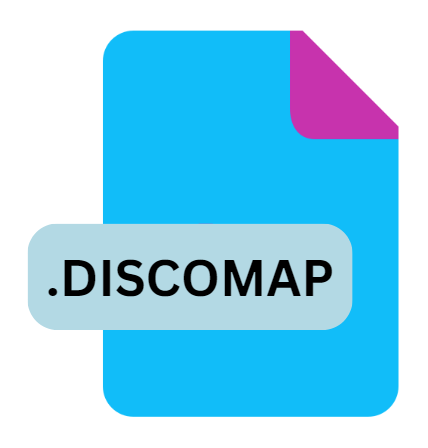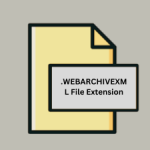.DISCOMAP File Extension

What is an DISCOMAP file?
The .DISCOMAP file extension is associated with DISCO (Dynamic Information System for Coordinated Operations) software.
These files are specifically known as DISCO Discovery Output Files. Designed to support the management and coordination of complex information systems, .DISCOMAP files play a crucial role in the storage and exchange of discovered data within the DISCO platform.
More Information.
Initially, DISCO was created to tackle challenges related to data integration and management across diverse operational environments.
The .DISCOMAP file format was introduced to handle the output of discovery processes where the system identifies, categorizes, and maps complex datasets.
The primary goal of the .DISCOMAP format was to facilitate efficient data transfer and analysis, ensuring that the discovered data could be easily accessed and utilized by various stakeholders within an organization.
Over time, the DISCO platform has evolved, incorporating advanced features and improving its data handling capabilities.
The .DISCOMAP file format has adapted to these changes, reflecting updates in the DISCO software and its functionalities.
Origin Of This File.
The .DISCOMAP file extension emerged alongside the development of DISCO, a software solution used for analyzing and managing large sets of operational data.
DISCO was developed to cater to needs in various sectors, including enterprise management, data analysis, and operational coordination.
As data handling requirements grew more complex, DISCO introduced specialized file formats like .DISCOMAP to streamline and standardize data output from discovery operations.
File Structure Technical Specification.
The .DISCOMAP file is structured to store detailed information about the results of a discovery operation. Here’s an overview of its file structure and technical specifications:
- Header Section: Contains metadata about the file, including version information, file creation date, and data integrity checks. This section helps in identifying the file and ensuring its compatibility with the DISCO software version.
- Data Blocks: The core of the .DISCOMAP file is composed of data blocks that store the results of the discovery operation. Each block contains specific information such as identified entities, their attributes, relationships, and any relevant metadata. These blocks are organized in a way that allows efficient parsing and retrieval of information.
- Index Tables: These tables provide a quick reference to the data blocks, facilitating fast access to specific sections of the file. Index tables are crucial for handling large files, as they enhance performance by reducing the time required to locate particular data.
- Footer Section: Includes checksums and end-of-file markers to verify the integrity of the file and signal the end of the data. This section ensures that the file is complete and uncorrupted.
Technical specifications of the .DISCOMAP file format are typically proprietary, with details closely guarded by the software developers. However, general practices in file format design ensure that .DISCOMAP files are optimized for efficient data storage and retrieval.
How to Convert the File?
Converting .DISCOMAP files typically involves using the DISCO software itself or specialized tools provided by the developers. Here are the general steps for converting .DISCOMAP files:
- Using DISCO Software: Open the DISCO software and load the .DISCOMAP file. The software may offer options to export or convert the file into other formats supported by the system. Common export formats might include CSV, XML, or JSON, depending on the requirements.
- Third-Party Tools: Some third-party tools and services may offer conversion options for .DISCOMAP files. Ensure that any tool you use is compatible with the specific version of DISCO and the .DISCOMAP file format to avoid data corruption or loss.
- Custom Scripts: Advanced users with programming knowledge may develop custom scripts to parse and convert .DISCOMAP files into other formats. This approach requires a deep understanding of the file structure and data contents.
Advantages And Disadvantages.
Advantages:
- Efficient Data Management: The .DISCOMAP format is designed to handle large volumes of data efficiently, making it suitable for complex discovery operations.
- Standardization: By using a standardized format, DISCO ensures consistency in data output, which simplifies data sharing and integration across different systems and platforms.
- Compatibility: .DISCOMAP files are specifically tailored for use with DISCO software, ensuring that they are fully compatible with the system’s features and functionalities.
Disadvantages:
- Proprietary Format: The proprietary nature of the .DISCOMAP file format can pose challenges for interoperability with other software solutions. Users may face difficulties if they need to work with data outside the DISCO environment.
- Complexity: The file structure, while efficient, can be complex for users unfamiliar with the format. This complexity can make it challenging to manually parse or edit .DISCOMAP files without specialized tools.
- Limited Support: As a niche file format, .DISCOMAP files may not be widely supported by third-party applications or tools, potentially limiting their utility in broader data management contexts.
How to Open DISCOMAP?
Open In Windows
- DISCO Software: The primary method for opening .DISCOMAP files on Windows is through the DISCO software. Install the software and use it to open and view the file.
- File Conversion: If the .DISCOMAP file is converted to a more common format, such as CSV or XML, it can be opened with various applications like Microsoft Excel or text editors.
Open In Linux
- DISCO Software for Linux: If available, use the Linux version of DISCO software to open .DISCOMAP files.
- Custom Scripts: Linux users may develop or use existing scripts to parse and convert .DISCOMAP files into more accessible formats for use with standard Linux applications.
Open In MAC
- DISCO Software for macOS: If a macOS-compatible version of DISCO is available, it can be used to open .DISCOMAP files. Check the software’s compatibility with macOS.
- Conversion Tools: Convert the .DISCOMAP file to a compatible format using DISCO or third-party tools, and then use macOS applications to open the converted file.













